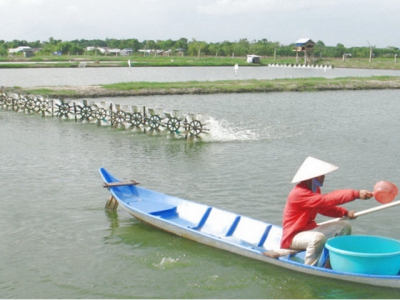Promoting strength from brackish shrimp farming

Soc Trang province possesses strength in developing the fisheries economy. Specifically, brackish shrimp farming is redirecting investment to high-tech applications, opening the direction of sustainable development.
Brackish shrimp farming in Soc Trang. Photo: HD.
Shrimp farmers have accumulated many experiences
Soc Trang is located at the end of the Hau River, adjacent to the East Sea with a coastline of more than 72 km and has the same goal as other coastal provinces of the Cuu Long Delta to promote the advantages of the marine economy. The province's fisheries have developed synchronously in all three fields of exploitation, farming and processing for export. Specifically, brackish water shrimp farming in the province is playing a key role, having great potential for development.
Thanks to the application of high technology in aquaculture such as: shrimp farming in 2 or 3 stages, using microorganisms, covering the bottom with tarpaulin,… shrimp farmers have quickly gained success, acquiring high farming efficiency.
Annually, the aquaculture area of Soc Trang province is over 78,000 ha. Particularly, brackish water shrimp farming area is over 51,400 ha by 2020, of which whiteleg shrimp is over 37,000 ha (accounting for over 72% of the farming area) and black tiger prawn is over 14,000 ha. Farmed shrimp production volume in 2020 will reach nearly 188,000 tons. Total seafood export turnover in 2020 reached USD 823 million, accounting for 75% of the province’s export turnover.
In recent years, shrimp farmers have accumulated a lot of experience and applied scientific and technical advances to shrimp farming models, improving farming efficiency. However, shrimp farming still possesses many potential risks, so it is necessary to always pay attention to disease prevention measures. Currently, shrimp diseases that cause damage mainly include white spot disease (WSS), Acute hepatopancreatic necrosis (AHPND), microspores (EHP) and many other causes such as environment, weather, and climate change.
Apply good production practices on over 1,600 ha
Determining that collective economic development is a key task in the production organization stage, Soc Trang's agricultural industry always promotes the establishment, consolidation and improvement of activities for cooperatives and cooperative groups. The province has drastically implemented Decision No. 445/QD-TTg of the Prime Minister and piloted inviting young staff to come and support cooperatives.
In order to help shrimp farming develop sustainably and meet the increasingly strict requirements of the market, Soc Trang Department of Agriculture and Rural Development also recommends that shrimp farmers apply the standards of aquaculture practice VietGAP, ASC, etc. BAP, GAP… and at the same time, organize connections between shrimp farmers, cooperatives, shrimp farms with factories and export seafood processing enterprises.
As a result, shrimp production and farming activities are better supported, creating a source of shrimp products that meet food hygiene and safety standards. The province has had 41 production units applying good production practices (VietGAP, ASC, GAP, GlobalGAP, BAP) on 1,600 ha.
In order to fully utilize brackish shrimp farming's strength, Soc Trang province has proposed the MARD to prioritize funding support for the implementation of investment projects to develop rice-shrimp areas in My Xuyen district in the period of 2021-2025 with 17,000 ha of land. The total investment is VND 500 billion, the project will build a pilot irrigation model in the high-tech shrimp farming area of Tran De district with a scale of 300 ha and a total investment of VND 232 billion.
Có thể bạn quan tâm
 Responding actively to illnesses on farmed shrimp in adverse weather
Responding actively to illnesses on farmed shrimp in adverse weather Unfavorable and extended hot weather, along with the fact that certain regions did not maintain a suitable environment for shrimp farming
 Environmental monitoring fosters shrimp farmers to avoid risks
Environmental monitoring fosters shrimp farmers to avoid risks Due to environmental monitoring, shrimp producers in Binh Dinh achieved a high yield despite unfavorable weather conditions.
 Adjustment to minimize difficulties in shrimp production 'capital'
Adjustment to minimize difficulties in shrimp production 'capital' In the past, Ninh Thuan had about 200-300 trucks each day transporting shrimp to the most consuming provinces in the south, there are only more than 80 trucks.